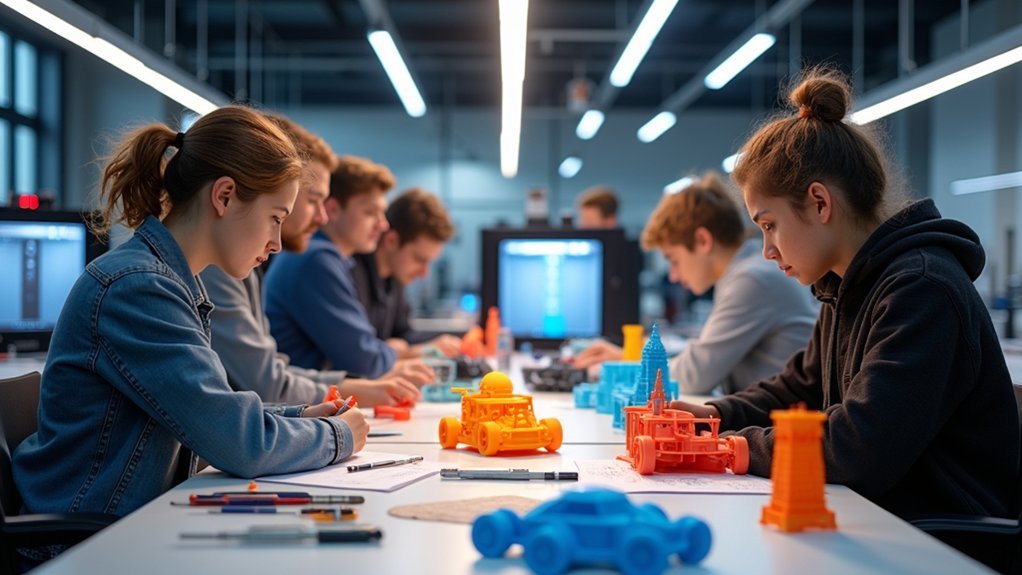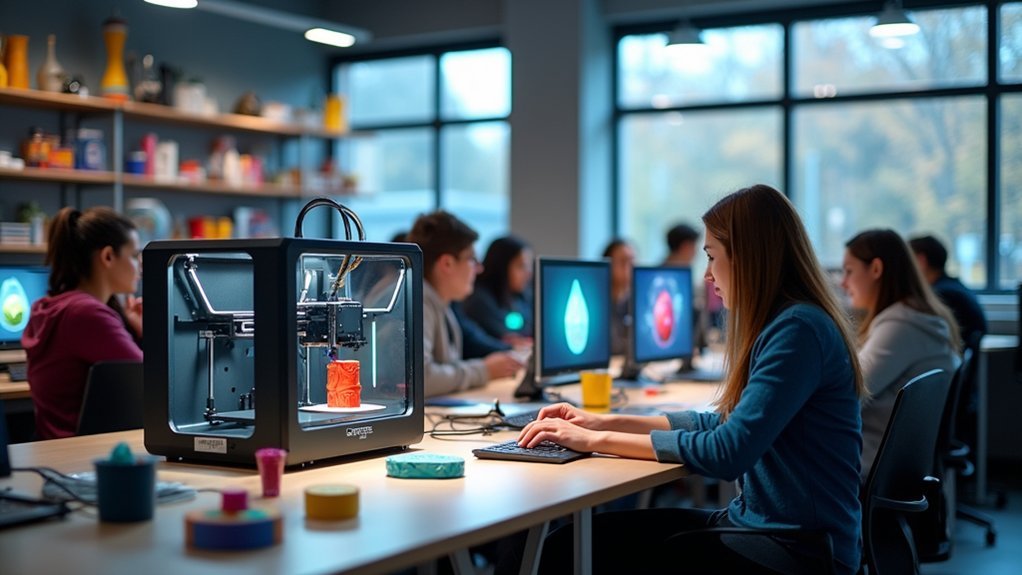You’ll find 3D printing technology revolutionizing university research and education by enabling rapid prototyping that costs under $15 compared to traditional methods that range from $500 to $1,500 per prototype. Universities use 3D printing for engineering concept visualization, medical device development, prosthetic creation, robotics component testing, paleontological model construction, artistic sculpture prototyping, and enhancing student accessibility through maker spaces. These applications transform abstract ideas into tangible models while fostering interdisciplinary collaboration and innovation across multiple academic disciplines.
Engineering and Design Concept Visualization

When you’re studying engineering or design, 3D printing transforms abstract concepts into tangible models you can hold, examine, and test. Instead of relying solely on digital screens or hand-drawn sketches, you’ll create physical prototypes that bring your ideas to life.
This hands-on approach helps students grasp complex engineering principles more effectively than traditional learning methods.
You’ll discover that 3D printing enables rapid iteration of your designs, allowing you to test multiple versions quickly and cost-effectively. Traditional prototyping methods can cost between $500 to $1,500, but 3D printing dramatically reduces these expenses.
You can explore intricate geometries and complex structures that would be impossible to achieve through conventional manufacturing processes, expanding your creative possibilities and enhancing your overall design capabilities.
Medical Device and Prosthetic Development
You’ll find universities at the forefront of medical innovation through 3D printing, where students create life-changing prosthetics for individuals with limb differences.
Your medical education becomes more hands-on as you work with printed anatomical models that replicate complex biological structures with remarkable accuracy.
These same technologies let you prototype surgical training tools and contribute to groundbreaking biomedical research that’s pushing the boundaries of regenerative medicine.
Custom Prosthetic Prototyping
While traditional prosthetic manufacturing can take weeks and cost thousands of dollars, 3D printing revolutionizes custom prosthetic prototyping by enabling universities to create personalized medical devices in hours for under $15 per prototype.
You’ll find universities like Duke transforming lives through rapid prototyping capabilities that make prosthetics accessible and functional. Their eNable club demonstrates how open-source designs create dynamic solutions tailored to individual needs.
Here’s how universities excel at custom prosthetic prototyping:
- Personalized modifications – You can alter grip designs for specific professions, like enabling pharmacy graduates to perform subcutaneous injections.
- Quick iterations – You’ll test multiple designs rapidly, refining functionality efficiently.
- Community collaboration – You’ll connect engineering students directly with recipients for personalized solutions.
- Lightweight, ergonomic designs – You’ll create comfortable prosthetics that enhance daily usability.
Surgical Training Models
Beyond creating prosthetic devices, universities harness 3D printing to revolutionize medical education through anatomically accurate surgical training models. You’ll find medical schools using this technology to create realistic practice materials that let students learn complex procedures without risking patient safety. These models provide hands-on experience with precise anatomical structures, improving skill development considerably.
| Traditional Training | 3D Printed Models |
|---|---|
| High cadaver costs | Lower material costs |
| Limited availability | On-demand production |
| Single-use specimens | Reusable practice tools |
The cost advantages are substantial—you’re looking at dramatically reduced training expenses compared to traditional cadaver-based methods. Universities can now provide extensive surgical education while maintaining budget efficiency. Students gain confidence through repeated practice on identical anatomical models, ensuring consistent learning experiences across medical programs.
Biomedical Research Applications
Universities leverage 3D printing technology to accelerate biomedical research through innovative medical device and prosthetic development.
You’ll find research teams creating customized implants and prosthetics that meet specific patient requirements, markedly reducing development timelines from weeks to hours.
Medical students benefit from hands-on training with detailed anatomical models, while engineering and medical disciplines collaborate more effectively.
Duke University’s eNable club exemplifies this innovation by using open-source designs to create personalized prosthetics.
Key advantages of 3D printing in biomedical research include:
- Rapid prototyping – Iterate designs quickly for immediate testing
- Cost reduction – Considerably lower production expenses than traditional methods
- Customization – Tailor medical devices to individual patient anatomy
- Enhanced collaboration – Bridge engineering and medical expertise effectively
This technology transforms how you’ll approach patient care and medical innovation.
Robotics Component Creation and Testing
You’ll find that robotics labs in universities are revolutionizing how they create and test components through 3D printing technology.
When you’re developing soft robots, you can now integrate rigid and flexible materials in a single print job, eliminating the complex assembly processes that traditional manufacturing requires.
This multi-material capability lets you prototype entire robotic systems faster and more cost-effectively than ever before.
Soft Robot Development
While traditional manufacturing methods require extensive time and resources for creating robotic components, 3D printing has revolutionized soft robot development in university research labs.
You can now rapidly prototype complex soft robotics using multi-material printing techniques that weren’t possible before.
The Wyss Institute at Harvard exemplifies this innovation with their soft-bodied jumping robot, demonstrating how universities leverage 3D printing for breakthrough research:
- Multi-material integration – Nine-layer material shifts combine rigid and soft components for enhanced durability
- Natural movement mimicry – Complex designs replicate biological locomotion patterns
- Rapid iteration cycles – Quick design modifications accelerate research timelines
- Custom component creation – Tailored parts enable exploration of novel soft robotics concepts
This advancement opens doors for applications in search and rescue missions and minimally invasive medical procedures.
Multi-Material Component Integration
Because traditional robotics manufacturing requires assembling separate rigid and flexible components, multi-material 3D printing transforms how you’ll create and test robotic systems in university labs. You can now integrate up to nine different material layers in a single print, eliminating assembly errors and reducing development time considerably.
| Traditional Method | Multi-Material 3D Printing |
|---|---|
| Separate component assembly | Single integrated print |
| Limited material combinations | Nine-layer material shifts |
| Time-intensive prototyping | Rapid iteration cycles |
| Assembly-related errors | Streamlined manufacturing |
| Complex geometry constraints | Unrestricted design freedom |
This technology enables you to test diverse mechanical properties within individual prototypes. Harvard’s Wyss Institute demonstrated this capability by developing soft-bodied jumping robots that seamlessly combine rigid and flexible elements, proving how multi-material 3D printing accelerates university research timelines.
Paleontological Research Model Construction

When you’re studying ancient life, 3D printing transforms how you can examine and understand extinct creatures through detailed model construction. This technology gives students the ability to manipulate physical replicas of fossils without damaging precious originals.
Universities leverage 3D printing for paleontological research in these key ways:
- Virtual skeleton mounting – Teams like Dr. Kenneth Lacovara’s create complete digital reconstructions from partial fossil discoveries, such as their 45% complete Dreadnoughtus schrani specimen.
- Bone and muscle modeling – Researchers like Kristyn Voegele produce detailed anatomical models that reveal movement patterns.
- Rapid replica production – Scientists generate multiple copies for collaborative study across institutions.
- Enhanced visualization – Physical models bridge theoretical knowledge with hands-on exploration of ancient biology.
Artistic Sculpture and Installation Prototyping
As you explore artistic creation, 3D printing revolutionizes how you can prototype sculptures and installations by turning digital concepts into tangible forms.
3D printing transforms artistic vision into reality, empowering creators to materialize complex digital sculptures that traditional techniques cannot accomplish.
You’ll discover that artists like Noah Gunther from Lawrence University create intricate installations such as “Mystery Ocean,” blending physical and digital environments to enhance artistic expression.
When you use 3D printing for artistic sculpture, you can rapidly prototype complex geometries and unique forms that traditional methods can’t achieve.
You’ll find universities provide access to this technology in art departments, allowing you to produce scale models reflecting your vision while gaining hands-on experience.
This integration encourages you to push creative boundaries, fostering interdisciplinary collaboration between design, engineering, and art programs for innovative projects.
Student Accessibility Through Maker Spaces

While artistic applications showcase 3D printing’s creative potential, maker spaces democratize access to this technology across entire student populations.
Universities establish dedicated facilities equipped with cutting-edge 3D printers, workstations, and design software that transform prototyping from an exclusive privilege into an accessible resource.
These maker spaces create dynamic learning environments where you’ll find:
- Peer mentorship programs where experienced students guide newcomers through 3D printing processes
- Interdisciplinary collaboration zones enabling cross-department project partnerships
- Community engagement opportunities connecting classroom learning with real-world problem-solving
- Hands-on experimentation stations fostering innovation and creativity
You don’t need expensive equipment or specialized training to begin prototyping.
Maker spaces provide everything necessary for exploring 3D printing technology while building practical skills through collaborative, student-driven initiatives.
Process Optimization and Technology Enhancement
Beyond providing access to equipment, universities are revolutionizing the technology itself through systematic improvements to 3D printing workflows and hardware capabilities. You’ll find institutions like MIT advancing desktop printer designs with screw mechanisms that accelerate filament feeding, directly boosting efficiency.
Process optimization extends beyond hardware through integrated fleet software that guides you through streamlined workflows, ensuring higher success rates for your prototyping projects.
Technology enhancement enables groundbreaking applications you can’t achieve with traditional methods. Researchers at the Wyss Institute demonstrate this by creating soft-bodied robots through multi-material printing techniques.
You’ll benefit from universities’ ability to utilize diverse materials and printing methods, producing complex prototypes that test mechanical properties and design intricacies while maintaining rapid iteration cycles at reduced costs.
Frequently Asked Questions
How Is 3D Printing Used in Prototyping?
You’ll create physical models quickly and affordably, testing designs iteratively before final production. You can explore complex geometries, validate concepts, and refine prototypes through multiple design cycles, reducing both development time and costs considerably.
How Is 3D Printing Used in Schools?
You’ll use 3D printing in schools to rapidly prototype your design ideas, collaborate across subjects like engineering and art, and iterate improvements quickly using user-friendly CAD software that matches your skill level.
What Are the Benefits of 3D Printing Prototypes?
You’ll save massive costs, dropping prototype expenses from $1,500 to just $15. You can iterate designs quickly, create complex geometries impossible with traditional methods, and gain valuable hands-on experience for future career opportunities.
What Industries Might Use a 3D Model to Create a Prototype With?
You’ll find 3D printing used across medical, automotive, aerospace, fashion, and consumer electronics industries. They create prototypes for surgical training, parts testing, lightweight components, garment designs, and device development respectively.





Leave a Reply